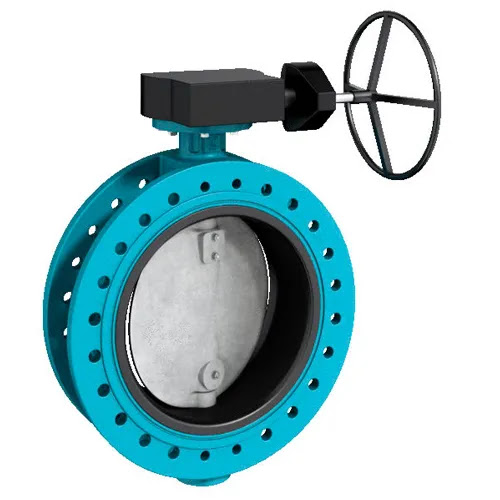BUTTERFLY VALVE
Butterfly valves are quarter-turn valves that are popular for on-off or modulating services. They are lightweight, have a small installation footprint, lower cost, quick operation, and are available with large orifice sizes. The “butterfly” is a disk connected to a rod. When the valve opens, the disk rotates to allow fluid to pass through. It closes when the rod rotates the disc by a quarter turn to a position perpendicular to the flow direction.
3 Main Butterfly Valves Types:
1) Zero-Offset Butterfly Valves:
Concentric or Rubber Seated are other names for the Zero-offset Design. Zero-offset means there is no offset by the stem of the valve. the valve seals via interference along the disc edge at the stem between disc and the rubber seat.
The rubber seated valves has the lower (up to 250 psi) and withstands heat up to 400°F. Its rubber seat encases the body to prevent contact with material which maintains the purity of media.
2) High-Performance Double Offset Butterfly Valves:
This type of valve is refereed to as double offset because the offset is in two places, at the line of the disc seat/body seal, and the bore. Off-center positioning increases durability for the seal. High-performance valves tolerate pressure up to 1440 PSI and temp up to 1200°F.
3) Triple Offset Butterfly Valve:
The best type of butterfly valve for high-pressure systems is the triple offset butterfly valve. This valve is most advanced with Lower emissions and is designed to work with various environments. Its heat tolerance is 1200°F as it can withstand 1480 psi.
working principle
The construction of a butterfly valve is relatively simple, with the rotation of the valve disc controlling the fluid flow. In the closed position, the disc blocks the valve bore while in the open position, the disc is oriented perpendicular to the flow direction to allow flow. Butterfly valves generally provide bi-directional flow and shutoff capability. However, they are not full-bore, which renders them unsuitable for pigging or swabbing. The body material is ductile iron with an epoxy powder coat on both internal and external surfaces. The valves are typically operated by handwheels, gears, or actuators, or a combination thereof, according to the specific application requirement and technical specifications.
Butterfly valve parts
Below are the major butterfly valve components:
- Valve Body
The valve body fits between the pipe flanges - the most common end connection types being flanged, double lug, and wafer types.
- Disc
Attached to the valve body is the disc that functions as a gate that stops or throttles fluid flow; it can be considered equivalent to a gate in a gate valve, or a ball in a ball valve. The disc is typically bored to receive the stem, or shaft. There are many variations in disc design, orientation, and material in order to improve flow, sealing, and/or operating torque.
- Seat
Lining the internal valve body is a strong elastomer or metal anti-leak seal that secures the disc in place in the closed position in order to achieve complete shutoff. stainless steel weld filled and microfinished integral body seat ensures a corrosion and erosion resistant seat face.
- Stem
The valve shaft, often also referred to as the stem, is the component that connects the disc to the actuation mechanism and transmits the torque through itself.
- Seals
Seals are present at multiple interfaces within the valve to either ensure a tight seal during operation or to isolate the process media from the valve’s internal components for a more flexible and cost-efficient design.
Sealing on seat face is ensured by a continuous T-profile resilient sealing ring which is held on the periphery of the disc by a retaining ring, preventing the sealing ring from rolling out. In the closed position, the sealing ring is pressed against the seat face, providing a tight seal on both the upstream and downstream ends. In the open position, the sealing ring is completely unstressed due to the double eccentric disc design.
Advantages of butterfly valves
Depending on the application, butterfly valves can offer significant advantages over other types of valves, especially for dimensions over DN 200 (200 mm) in size:
- Lightweight and Compact: With a compact design and a smaller face to face dimension, butterfly valves have a considerably less installation footprint and offer savings in the form of lower installation costs including labour cost, equipment, and piping support.
- Low Maintenance Requirements: An inherently simple, economic design that consists of few moving parts, and hence fewer wear points, significantly reduces their maintenance requirements.
- Fast Acting: A 90° rotation of the handle, or the actuation mechanism, provides a complete closure or opening of the valve. However, with larger butterfly valves, a gearbox is often required as part of the actuation mechanism which reduces the operational torque and simplifies the operation of the valve but comes at the expense of speed.
- Low Cost: Owing to their simple design, butterfly valves require less material and are simpler to design and manufacture and are often the more economical choice compared to other valve types.






























Great post i got lots of information from here. Thanks for sharing this post with us. If you are looking for Pneumadyne Valve In USA then contact us.
ReplyDeletethis was very helpful, thank you for this blog. for the same, you can visit our website : AutoCAD® P&ID Certification Training
ReplyDelete